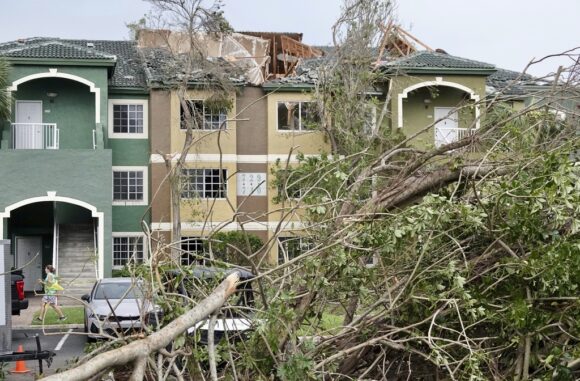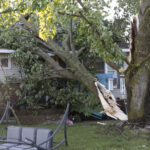Global natural catastrophes cost insurers US$50 billion in the first half, (H1 2022: $48 billion), with most of the losses stemming from severe convective storms, according to Swiss Re.
“Severe convective storms – storms associated with thunder, lightning, heavy rain, hail, strong winds and sudden temperature changes – caused US$35 billion (nearly 70%) in insured losses worldwide in the first half of 2023,” said the Swiss Re Institute report.
“This means that insured losses [for severe convective storms] are almost twice as high in a six-month period as the annual average of the last 10 years (US$18.4 billion),” which highlight the increasing loss impacts of secondary perils, Swiss Re continued.
Global Natural Disasters Cost Insurers $43B in H1, Surpassing 10-Yr Average: Munich Re
US thunderstorms cost insurers US$34 billion, or 68% of global insured natural catastrophe losses – the highest-ever insured losses in a six-month period. Swiss Re added. The report noted that 10 events each in the US caused losses of US$1 billion and above, compared to an annual average of six events for the previous 10 years, with Texas as the most affected state.
Other findings from the report were:
- Overall economic losses from natural catastrophes amounted to US$120 billion in H1, compared to US$123 billion during the prior-year period, which is 46% above the ten-year average.
- The single costliest disaster both in terms of economic and insured losses was the February earthquake in Turkey and Syria, which had an insured price tag of US$5.3 billion. The preliminary estimate for economic losses are US$34 billion, according to the World Bank. (Overall economic losses include insured and uninsured losses).
- Overall insured losses of US$50 billion in the first half were the second highest insurance price tag since 2011.
- New Zealand was hit by severe weather events just two weeks apart in early 2023 – from flooding and Cyclone Gabrielle – which became the two costliest weather-related insured loss events in New Zealand since 1970. Combined insured losses for the two events were estimated to be US$2.3 billion.
- Heavy rainfalls in northern Italy’s Emilia-Romagna region in mid-May led to extensive flooding and expected insured losses of more than US$600 million, causing the costliest weather-related event in the country since 1970. Estimated economic losses were US$10 billion.
- Overall global man-made catastrophes cost insurers $4 billion during the first half, compared with $5 billion in H1 2022. The economic costs of man-made catastrophes were $5 billion in H1, compared with $6 billion in H1 2022.
“With severe thunderstorms as the main driver for above-average insured losses in the first half of 2023, this secondary peril becomes one of the dominant global drivers of insured losses,” commented Martin Bertogg, head of Catastrophe Perils at Swiss Re, in a statement.
“The above average losses reaffirm a 5%-7% annual growth trend in insured losses, driven by a warming climate but even more so, by rapidly growing economic values in urbanized settings, globally. The cyclone and flood events in New Zealand in the first quarter of 2023 are testimonies of the risk to today’s large urban centres, continuing patterns observed in 2021 in the Germany flooding, and in 2022 in Australia and South Africa,” he added.
The effects of climate change are evident in increasingly extreme weather events such as heatwaves, droughts, floods and extreme precipitation, according to Jérôme Jean Haegeli, Swiss Re’s group chief economist.
“Besides the impact of climate change, land use planning in more exposed coastal and riverine areas, and urban sprawl into the wilderness, generate a hard-to-revert combination of high value exposure in higher risk environments. Protective measures need to be taken for insurance products to remain economical for such properties at high risk. It is high time to invest in more climate adaption,” Haegeli continued.
Photograph: Downed trees appear near a property with a damaged roof after a reported tornado hit the area Sunday, April 30, 2023 in Palm Beach Gardens, Fla. (Joe Cavaretta/South Florida Sun-Sentinel via AP)
Was this article valuable?
Here are more articles you may enjoy.



 Truckers Who Fail English Tests Are Pulled Off Roads in Crackdown
Truckers Who Fail English Tests Are Pulled Off Roads in Crackdown  State Insurance Legislators ‘Greatly Disturbed’ by Trump AI Regulation Order
State Insurance Legislators ‘Greatly Disturbed’ by Trump AI Regulation Order  One of Highest Property Claims Severity Recorded in Q3 on Low Volume, Says Verisk
One of Highest Property Claims Severity Recorded in Q3 on Low Volume, Says Verisk  WTW to Acquire Newfront in Deal Worth Up to $1.3B
WTW to Acquire Newfront in Deal Worth Up to $1.3B 

